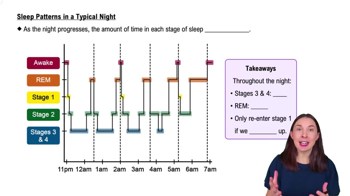Table of contents
- 1. Introduction to Psychology1h 43m
- 2. Psychology Research2h 20m
- 3. Biological Psychology2h 41m
- 4. Sensation and Perception28m
- 5. Consciousness and Sleep32m
- 6. Learning41m
- 7. Memory34m
- 8. Cognition37m
- 9. Emotion and Motivation35m
- 10. Developmental Psychology33m
- 11. Personality48m
- 12. Social Psychology41m
- 13. Stress and Health41m
- 14. Psychological Disorders44m
- 15. Treatment47m
5. Consciousness and Sleep
Sleep
Struggling with Psychology?
Join thousands of students who trust us to help them ace their exams!Watch the first videoMultiple Choice
Dr. Sardonicus is studying the effects of aging on memory. She gives an initial test of memory to a group of 20-year-olds and a group of 40-year-olds. Then she follows both groups of participants for a period of five years, regularly giving them memory tests during that time. Which research design is Dr. Sardonicus using?
A
Longitudinal
B
Cross-sequential
C
Cross-sectional
D
Genetic-potential
 Verified step by step guidance
Verified step by step guidance1
Identify the key components of the research design: Dr. Sardonicus is studying two different age groups (20-year-olds and 40-year-olds) and follows them over a period of five years, regularly testing their memory.
Understand the characteristics of a longitudinal study: This design involves studying the same group of participants over a long period to observe changes and developments.
Understand the characteristics of a cross-sectional study: This design involves comparing different groups at a single point in time to identify differences or similarities.
Understand the characteristics of a cross-sequential study: This design combines elements of both longitudinal and cross-sectional studies by studying several groups of different ages over time.
Analyze the research design used by Dr. Sardonicus: Since she is studying different age groups over a period of time, regularly testing them, this aligns with a cross-sequential design, which allows for observing changes over time while comparing different age groups.

 3:25m
3:25mWatch next
Master Circadian Rhythms with a bite sized video explanation from Hannah Gordils
Start learningRelated Videos
Related Practice


































































































![Race, Genes and IQ Differences | Bret Weinstein [Mini Clip]](https://img.youtube.com/vi/IztL_m3pd70/mqdefault.jpg)



































































































